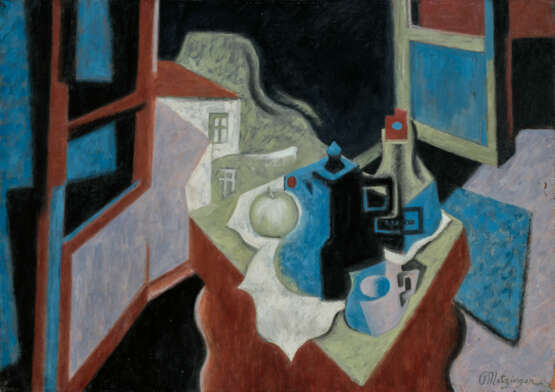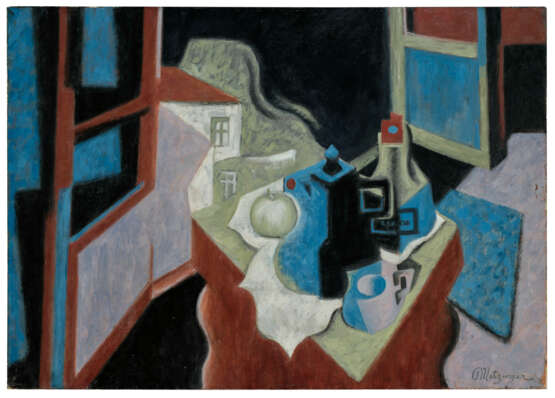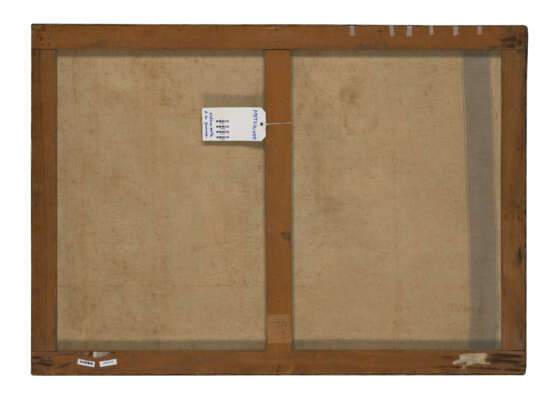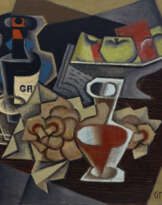ID 1178562
Lot 118 | Jean Metzinger (1883-1956)
Estimate value
€ 100 000 – 150 000
Nature morte à la pomme
signé 'Metzinger' (en bas à droite)
huile sur toile
65.4 x 92 cm.
Peint vers 1921
signed 'Metzinger' (lower right)
oil on canvas
25 5⁄8 x 36 ¼ in.
Painted circa 1921
Provenance
Galerie l'Effort Moderne (Léonce Rosenberg), Paris (no. 7618).
Docteur Gilet, Paris.
Collection particulière, Paris.
Acquis auprès de celle-ci par la famille du propriétaire actuel en octobre 1973.
Further details
« Aux libertés partielles conquises par Courbet, Manet, Cézanne et les impressionnistes, le cubisme substitue une liberté infinie. »
A. Gleizes et J. Metzinger, Du cubisme, Paris, 1912.
"Cubism replaces the partial freedoms won by Courbet, Manet, Cézanne and the Impressionists with infinite freedom."A. Gleizes and J. Metzinger, Du cubisme, Paris, 1912.
Bien que Picasso et Braque, sous l’influence de Cézanne, soient généralement crédités de l'invention du cubisme, il est essentiel de reconnaître le rôle significatif de Jean Metzinger dans le développement et la conceptualisation de ce mouvement artistique, véritable révolution esthétique qui s'est épanouie dans le bouillonnement créatif de l'avant-garde parisienne du premier quart du XXème siècle.
Théoricien et figure de proue du mouvement cubiste de la Section d'Or, souvent désignée sous le nom de Groupe de Puteaux, Jean Metzinger joue un rôle central dans sa diffusion dès 1911. Cette année-là, au Salon des Indépendants, il s’entoure d’autres artistes partageant ses idées, tels que Delaunay, Léger, Le Fauconnier, ou Gleizes. En octobre de la même année, le groupe prend l'initiative d'organiser le Salon de la Section d'Or au sein de la Galerie la Boétie, événement dont le nom a été suggéré à Raymond Duchamp-Villon par le Traité de la peinture de Léonard de Vinci. Se détachant du cubisme de Picasso et de Braque, le groupe élabore et conceptualise un nouveau cadre esthétique guidé par le principe de la proportion divine de la Renaissance, le « nombre d'or ». Le nom du groupe trouve son origine dans les travaux du mathématicien grec Phidias, selon lequel il existe une proportion idéale présente dans de nombreux aspects de la nature et de l'art, symbole de perfection et d'harmonie.
C’est en collaboration avec Albert Gleizes que Jean Metzinger écrit l’année suivante, en 1912, le premier traité majeur sur le cubisme, Du Cubisme, donnant ainsi pour la première fois une assise intellectuelle et théorique au mouvement. Cette publication joue un rôle crucial dans la diffusion des idées cubistes et dans leur compréhension par le public et les artistes contemporains. Léonce Rosenberg, directeur de la Galerie de l'Effort Moderne, galerie d'où provient la présente œuvre, a également joué un rôle crucial dans la promotion et la diffusion des idées novatrices portées par les artistes de la Section d'Or. Par son engagement inébranlable envers l'art moderne et son audacieuse sélection d'œuvres, Rosenberg a agi en tant que véritable catalyseur de cette révolution artistique en gestation, n’ayant de cesse de soutenir les artistes dans leur production.
Dans la présente Nature morte à la pomme, la cafetière, la tasse et la pomme sont déconstruites et recomposées selon les principes géométriques caractéristiques du mouvement cubiste. Les formes sont fragmentées en facettes angulaires, créant une sensation de dynamisme dans la composition. La tasse est représentée sous plusieurs angles simultanément, comme si elle était vue en même temps du dessus et de profil. La fenêtre est quant à elle simplifiée en formes géométriques élémentaires, et ouvre sur un paysage urbain qui se fond dans la composition du premier plan. Les couleurs sont réduites à une palette restreinte de tons terreux, accentuant l'aspect géométrique de la composition, illuminée par de larges aplats de turquoise et de rose, accentuant ainsi les contrastes de couleurs. L'espace pictural est fragmenté par une superposition de plans et de perspectives multiples, défiant ainsi les conventions de la représentation traditionnelle de l'espace.
Although Picasso and Braque, under the influence of Cézanne, are generally credited with inventing cubism, it is essential to acknowledge the significant role played by Jean Metzinger in the development and conceptualisation of this artistic movement, a veritable aesthetic revolution that flourished in the creative ferment of the Parisian avant-garde in the first quarter of the twentieth century.
Theorist and figurehead of the Section d'Or cubist movement, often referred to as the Groupe de Puteaux, Jean Metzinger played a central role in its dissemination from 1911 onwards. That year, at the Salon des Indépendants, he surrounded himself with other like-minded artists such as Delaunay, Léger, Le Fauconnier and Gleizes. In October of the same year, the group took the initiative of organising the Salon de la Section d'Or at the Galerie la Boétie, an event whose name had been suggested to Raymond Duchamp-Villon by Leonardo da Vinci's Traité de la peinture. Breaking away from the cubism of Picasso and Braque, the group developed and conceptualised a new aesthetic framework guided by the Renaissance principle of divine proportion, the "golden ratio". The group's name derives from the work of the Greek mathematician Phidias, who believed that there was an ideal proportion present in many aspects of nature and art, a symbol of perfection and harmony.
The following year, in 1912, Jean Metzinger, in collaboration with Albert Gleizes, wrote the first major treatise on Cubism, Du Cubisme, giving the movement its first intellectual and theoretical foundation. This publication played a crucial role in the dissemination of Cubist ideas and their understanding by the public and contemporary artists. Léonce Rosenberg, director of the Galerie de l'Effort Moderne, from which the present work originates, also played a crucial role in promoting and disseminating the innovative ideas of the artists of the Section d'Or. Through his unwavering commitment to modern art and his bold selection of works, Rosenberg acted as a catalyst for this emerging artistic revolution, constantly supporting the artists in their production.
In Nature morte à la pomme, the coffee pot, cup and apple are deconstructed and recomposed according to the geometric principles characteristic of the Cubist movement. The forms are fragmented into angular facets, creating a sense of dynamism in the composition. The cup is represented from several angles simultaneously, as if seen from above and in profile. The window is simplified into elementary geometric shapes, and opens onto a cityscape that blends into the foreground composition. The colours are reduced to a limited palette of earthy tones, accentuating the geometric aspect of the composition, which is illuminated by broad flat tones of turquoise and pink, accentuating the colour contrasts. The pictorial space is fragmented by a superimposition of planes and multiple perspectives, defying the conventions of traditional spatial representation.
| Artist: | Jean Metzinger (1883 - 1956) |
|---|---|
| Applied technique: | Oil on canvas |
| Genre: | Still life |
| Auction house category: | Paintings, Watercolors, Drawings, Paintings |
| Artist: | Jean Metzinger (1883 - 1956) |
|---|---|
| Applied technique: | Oil on canvas |
| Genre: | Still life |
| Auction house category: | Paintings, Watercolors, Drawings, Paintings |
| Address of auction |
CHRISTIE'S 9 Avenue Matignon 75008 Paris France | ||||||||||||||
|---|---|---|---|---|---|---|---|---|---|---|---|---|---|---|---|
| Preview |
| ||||||||||||||
| Phone | +33 (0)1 40 76 85 85 | ||||||||||||||
| Fax | +33 (0)1 40 76 85 86 | ||||||||||||||
| Conditions of purchase | Conditions of purchase | ||||||||||||||
| Shipping |
Postal service Courier service pickup by yourself | ||||||||||||||
| Payment methods |
Wire Transfer | ||||||||||||||
| Business hours | Business hours
|













